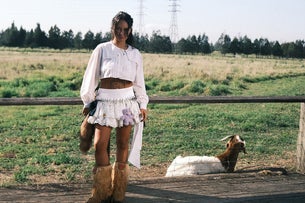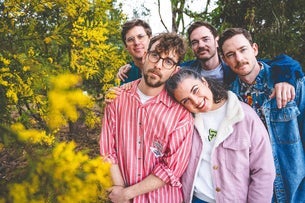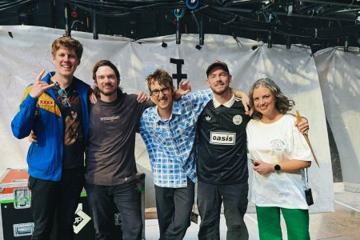 Ball Park Music
Ball Park Music"It was really scary," Cromack recalls. "I mean, it was terrifying to say to my bandmates that I was absolutely not vibing writing new stuff at the time. I needed a break and wanted to do the solo record. I was terrified of telling them that, but it was the best move I could have made because by the time I wrapped up the [solo project] My Own Pet Radio stuff I was excited to be playing with Ball Park again, and getting some different music out of my system gave me clarity on what I should do with the band. That was our biggest problem; I was still writing songs and we were still working on stuff, but stylistically or whatever we were so lost. We just didn't know where to go next, and I'm so pleased with the solution we ended up finding for this new record."
He says the band should have done it years ago. "We finally just said, 'Fuck it, let's not try to be anything we're not. Let's just play with the five of us. Let's just get in a room. Let's be the rock band that we essentially are. Let's make it kind of like our live show and just rock the fuck out.' Another big part of it was deciding to go to a studio where it was going to be analogue. And not just analogue, but we decided to work to a four-track machine, which was going to force this particular vibe on it and make it feel like a band rocking out. I get really sick of bands saying, 'We did a live-sounding record,' when it doesn't actually sound that live at all. We wanted to put some big restrictions on ourselves so that we really had to play like it was the sixties or whatever."
The final result sounds grittier than ever, resembling the production on Museum more so than any of their other records. "The first album we also recorded to tape, although that was a sixteen-track tape, so the process didn't end up being a whole lot different to recording to a computer. We did lots of things one at a time and got to do it with layers, so it sounds fairly modern. The same again on Museum, but I think our songwriting process really changed there. We were trying to be a bit fancier in the studio, and we also felt that our first record was so fucking jangly and annoying that we felt compelled to sort of retaliate against that a little bit, and make it more of a stubborn record, which is why Museum has held up as one of my favourites, even though it felt weird at the time."
"We were trying to be a bit fancier in the studio, and we also felt that our first record was so fucking jangly and annoying that we felt compelled to sort of retaliate against that a little bit."
The band produced their Puddinghead album next, recording it digitally themselves. "I thought that because I was in the hot seat as the producer that I would end up making this interesting, experimental record that would be along the lines as some of My Own Pet Radio stuff, but I don't know. I just turned into a massive wussy and made this really kind of shiny, poppy record. I don't hate it, but it's just really poppy to me and it's weird to listen back to. And also, we were in a funny headspace then. We had this kind of unhealthy ambition when we were making that record. I think we still really wanted to land a song on commercial radio and try step up to this next level of success. I mean, a lot artists go through that phase. You've got all these people in your ears about what you should try and do next. I just think that stuff is kind of poisonous, and we didn't have that this time around. It's possibly the best feeling that's been absent on all of our previous records. We weren't trying to achieve anything, we were just trying to make music together. That sounds a bit bloody naff, but that's how I would describe it."
Don't miss a beat with our FREE daily newsletter
The songs for the new album were mostly written over a long period of time, which Cromack says is often the case with his records. "I mean, there's a few songs that pop up that are fresh for the album, like Nihilist Party Anthem and Pariah. Some of the others have been kicking around for much longer. In fact, a lot of them were written during the time I wrote [My Own Pet Radio's] Goodlum. A few of the kinds of stories from the the books that I was reading while I wrote that record have ended up on this one."
He mentions So You've Been Publicly Shamed by Jon Ronson, but is quick to talk about his new inspiration. "Lately, I've been interested in fictional works again. For years all I could do was read the news, read non-fiction, or watch documentaries, and finally I'm getting back into some fiction because I feel like you can remove yourself from people's day-to-day bullshit. Sometimes it can be interesting, but it's just exhausting. It never ends. The world is always churning over more news, more events, and I feel like maybe I'm due for a return to fictional stimulation so that I can learn things about people, but not from the real world."
This more abstract approach to creating meaning isn't just one Cromack applies to his writing, but also to his artwork, which once again graces the cover of this fourth Ball Park record. "I remember the day when I essentially had to pitch that front cover to everybody. I knew everyone would be like, 'What's the artwork going to be?' and I was anxious about saying, 'Well, this is what I want to do. It's two coloured blobs on a plain background.' I was absolutely panicking about what everyone was going to say."
Thankfully, the band loved it, and it serves as a perfect representation of the album. "It's stubborn, and artworks in that style are about evoking a feeling more than they are more about telling a story. I actually did the painting for the front cover with a friend of mine who's a good artist. The final cover ended up being one of my artworks, but he did some painting with me and we talked a lot about that minimalistic style and those artists like Mark Rothko. He was one of the artists that helped pioneer that style, and of course he was criticised at the time. People said the usual, 'It's just fucking blobs and colour, it means nothing.' But he was all about trying to evoke a feeling, and would make his original artworks deliberately large. He would construct his own canvasses that were huge, and you were actually meant to see the painting and experience it by standing right in front of it. It was meant to be so large and intimidating, and it was just meant to give you a feeling. That's all you were supposed to take from it. I really adore that sentiment, because I think there are a lot of things in life where discussing it doesn't bring you any closer to the purpose of what it's trying to do."



















